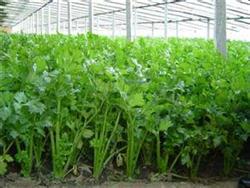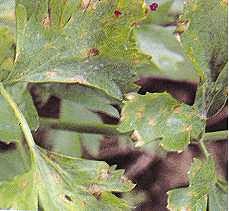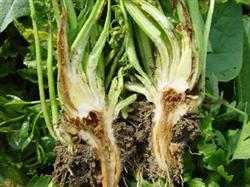Water and Fertilizer Management of celery in greenhouse

First, when the buds top the soil at the seedling stage, gently water once, and the seedlings can come out in 1 or 2 days. Keep the soil moist in the future, based on the principle of frequent watering and less watering. When the seedling height is 10 cm, it can be fertilized with water for 1 and 2 times. Second, planting and squatting seedlings should be watered frequently and gently to keep the soil moist from planting to slow seedling; after slow seedling, the amount of water should be controlled and mid-tillage (depth 1 inch) should be carried out, squatting seedlings, so that the root is tied down and the differentiation of heart leaves is accelerated. Vegetative growth period this period is the key period for the formation of yield. After the end of squatting seedlings, it is necessary to concentrate fertilizer and water to promote the vegetative growth of plants. Generally, quick-acting nitrogen fertilizer is applied immediately after squatting seedlings, and then applied 2-3 times in stages, paying special attention to applying a certain amount of potassium fertilizer, because celery is a potassium-loving vegetable. Water is watered every 3-4 days, but the amount of water is less, so that the ground temperature is too low is not conducive to petiole hypertrophy. About half a month before harvest, the whole plant could be sprayed with gibberellin 30~50ppm for 1 or 2 times, and the effect of increasing yield was better. Nitrogen deficiency in celery showed that the leaf was small and the petiole was prone to hollow and aging. Phosphorus deficiency in the early stage and potassium deficiency in the later stage had great effects on the yield and quality of celery. Liquid phosphorus and potassium fertilizer could be sprayed respectively in the earlier and later stages. In addition, celery is very sensitive to boron fertilizer, and the stem is cracked when boron is deficient, which can be controlled by applying 0.5-0.75 kg borax per mu.
- Prev

Control of celery late blight in greenhouse
Celery late blight, also known as spot blight and leaf spot, is a common disease in celery. The late blight of celery planted in greenhouse is more serious than that of celery in open field, which has a great effect on the yield and quality of celery. Occurrence characteristics: celery late blight is a fungal disease, which can survive the winter on seeds and remnants. Sow seeds.
- Next

Prevent celery heart rot in spring
Celery heart rot is a common physiological disease in celery production in spring. The tender tissue of celery grows black and dies. Subsequently, the celery root system and some stems and leaves also died one after another. The prevention and control methods are as follows: first, rational fertilization. Apply sufficient base fertilizer and increase phosphorus and potassium fertilizer and boron fertilizer to cultivate strong plants to improve disease resistance. No.
Related
- Where is it suitable to grow horseradish in China? it is expected to see the middle altitude horseradish in Alishan.
- How to prevent tomato virus disease reasonably? (Control methods included)
- Many people like to plant towel gourd on the balcony. What are the main points of this method and management?
- What crops can chili peppers be mixed with?
- Fertilization techniques and matters needing attention in Tomato
- What are the grafting techniques for peach seedlings in spring?
- Harm and control methods of root swelling disease of Chinese cabbage
- What are the pests of sweet potatoes? How to prevent and cure it?
- Symptoms, causes and Control methods of navel Rot in Tomato
- The cause of "Cucumber rotten bibcock" in Farmers' planting Cucumber and its Control Plan

